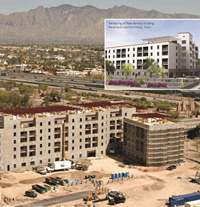http://admin.housingonline.com/Documents/TCA%20Issues/TCAma012.pdf
Tax Credit Advisor magazine, May 2012
New Arizona Seniors Project Made Possible By Tax Credits, Transfer Of Subsidy Contract
 The senior residents of Armory Park Apartments, a tired 38-year-old federally subsidized rental project in Tucson, Ariz., will be getting a treat in a few months — bigger apartments with no rent increase in a brand new six-story development a mile away.
The senior residents of Armory Park Apartments, a tired 38-year-old federally subsidized rental project in Tucson, Ariz., will be getting a treat in a few months — bigger apartments with no rent increase in a brand new six-story development a mile away.
“I’m excited about it,” says co-developer Steve Greenbaum, president of Chicago-based Senior Housing Group LLC. “The residents who have been living for a long time in small studios in the old Armory Park will all be living in one-bedrooms that are larger than their current units.”
Senior Housing Group and Evergreen Partners, a for-profit affordable housing developer based in Portland, Me., are the joint venture developers of the New Armory Building (working title), which is under construction and expected to be completed in June. But the path of the deal has been anything but simple, taking years to acquire Armory Park Apartments from its original owner, find and acquire a site for the new project, secure federal low-income housing tax credits and other financing, and obtain approval from the U.S. Department of Housing and Urban Development (HUD) to transfer the existing project-based Section 8 rental assistance contract and residents from the old property to the new.
“It’s been a long, challenging road to get from where we started to where we are today,” says Greenbaum, whose company acquires existing project-based Section 8 properties for seniors, generally from nonprofit owners, and renovates and recapitalizes them using housing credits and other resources and extends the affordability restrictions.
The New Armory Building will contain the same number of apartments as the old HUD Section 236 property, 142 LIHTC units and one manager’s unit. But the new units will all be modern, roughly 650-square-foot, one-bedroom apartments, compared to the predominantly small studios of mostly 412 square feet in the existing property. Just as at the existing building, 140 of the new apartments will have their rents subsidized by project-based rental assistance under a new 20-year Housing Assistance Payments (HAP) contract. Charlie Allen, a partner of Evergreen Partners in Ipswich, Mass., said the weighted average monthly rent for the new units — $713 plus a HUD-approved utility allowance — will be the same as for the old.
The new HAP contract will supplant the current HAP contract on the existing property that — with a five-year term — was slated to terminate in 2014 along with the Section 236 mortgage, Interest Reduction Payments (HAP) contract, and regulatory agreement. The new project will be subject to 30-year affordable use restrictions.
Of the 142 new LIHTC units, 8 will be rented to households at or below 40% of the area median income (AMI); 15, 50% of AMI; and the rest, 60% of AMI. The current income limit for a one-person household at 60% of AMI is $25,380.
The LEED-certified development, on the city’s West Side less than a half mile from downtown, will boast an array of amenities (e.g., community room, fitness center, library, food pantry, rooftop deck), rooftop solar panels generating electricity for common areas, twice as much parking, and be close to public transit. In addition, Allen said, “We will have a supportive services coordinator running a wide variety of social and resident assistance programs and connecting residents to services in the city.”
Preservation Management, Inc., an affiliate of Evergreen Partners, will be the property manager.
Funding sources for the nearly $27 million New Armory Building include $22.7 million in equity generated by the sale of federal housing tax credits to Wells Fargo, a deferred developer fee, and a permanent mortgage from Bank of America Merrill Lynch, which is also the construction lender. Wells Fargo paid 88 cents per dollar of tax credit for the housing credits. The Arizona Department of Housing awarded approximately $2.7 million in 9% housing credits for the project in 2010.
A Change in Plans
New Armory is Senior Housing Group’s first LIHTC project in Tucson and came about in a circuitous manner. While a principal at a previous company, Urban Innovations (UI), Greenbaum and other UI principals formed a tax credit partnership that acquired an existing HUD Section 202 property in Tucson to redevelop in December 2007. “Logistically it was hard to own just one building that far away from our home base,” Greenbaum says. “So I started looking for other preservation opportunities in Arizona.”
He came across Armory Park Apartments, an aging development owned by the Tucson Armory Park Foundation, a nonprofit formed by some local churches in the 1970s to develop the project. “They had some significant vacancy issues at the property, some significant physical impairment issues, and were looking for ways to improve the building while preserving it as affordable housing,” Greenbaum says.
Greenbaum’s initial proposal to the Foundation was to acquire and renovate the existing building to preserve it as affordable housing. “But over time and with more diligence on the physical structure,” he says, “we realized that was not a feasible project to invest in.” Some of the building’s systems needed major work; 70% of the apartments were studios that were tough to lease; and the building’s construction was poured reinforced concrete, making it virtually impossible to reconfigure the property into larger apartments. After discussions with the Arizona Department of Housing (DOH) and tax credit investors, Greenbaum recognized that it would be hard to obtain 9% tax credits and equity for an acquisition/rehab project.
Enter a change in plans. Greenbaum recalls standing with others on the building’s roof one day, seeing vacant land in the vicinity, and saying, “Wouldn’t it be great, instead of buying and rehabbing this building, where you still have an old building that’s almost all studios, if we could build a replacement building for the residents somewhere close to where we’re standing.”
A partnership controlled by Greenbaum and other UI principals signed a contract to purchase the Armory Park Apartments in November 2009, and planned to apply to DOH in March 2010 for 9% tax credits for a new replacement building. But Greenbaum first had to find a site. “Finding a development site that made sense and would be just as good if not better for the residents was challenging,” he says.
After scouting multiple potential sites, Greenbaum discovered a vacant 14-acre parcel of land a mile away owned by the City of Tucson, which had designated the property for large-scale redevelopment and selected a master developer. In February 2010, on behalf of the same partnership holding the rights to purchase Armory Park Apartments, Greenbaum signed a contract to buy part of the vacant parcel as the site for the New Armory Building. In March 2010, Greenbaum left UI and started Senior Housing Group, bought the contractual rights for both the development site and the existing building from his former UI partners, and applied for 9% tax credits for the new project.
With plenty on his plate — ramping up a new company and several tax credit projects in the works — Greenbaum approached Evergreen Partners to be a joint venture partner on the New Armory Building and share the workload. Besides financial strength and a long proven track record in redeveloping federally assisted housing projects using tax credits, Evergreen Partners had previous experience in getting HUD to approve transfers of Section 8 HAP contracts. Greenbaum had done one such transfer previously between two properties in Pennsylvania.
Lengthy Approval Process
Allen says it took about a year to get HUD to approve the transfer of the HAP contract from Armory Park Apartments to the new development plus a new 20-year contract, requiring talks with officials in HUD’s Phoenix field and San Francisco Hub offices and HUD Headquarters in Washington, D.C. “Getting the subsidy transferred and approved was not an easy matter,” he notes.
To win approval of a transfer of the contract to the new project under a provision of a previous HUD appropriations bill (Section 212, formerly Section 318), the developers had to convince HUD that Armory Park Apartments was physically obsolete or not economically viable, which it accomplished. Says Allen, “We spent a long time explaining that it’s economically nonviable because we cannot generate capital to replace HVAC, windows, elevators, and all the things that need to be done with a product that is obsolete with all these small studio units that can’t be reconfigured.”
HUD’s preliminary comfort letter of support for the transfer of the contract was included in Greenbaum’s LIHTC application package submitted in March 2010.
A partnership controlled by Greenbaum purchased Amory Park Apartments in April 2011. The SHG/Evergreen controlled tax credit partnership closed on the financing for the new project and acquired the site for $1.43 million in May, and construction began in June.
After the New Armory Building is completed and the residents moved in from Armory Park Apartments, Greenbaum’s goal is to sell the old, vacant property to an interested party for conversion to market-rate or student housing, a hotel, or some other use.
Source and Uses Summary
SOURCES
9% Federal LIHTC Equity (Wells Fargo) .........................$22,712,728
First Mortgage (Bank of America Merrill Lynch,...................$2,945,000
30-year, 7%)
Developer Contributions ...............................................$1,338,905
Total Sources............................................................$26,996,633
USES
Acquisition.................................................................$1,430,000
Construction..............................................................$19,216,250
Professional Services ....................................................$1,157,420
Interim Costs.................................................................$184,719
Tax Credit Fees and Costs.................................................$252,614
Financing Costs ...............................................................$69,010
Other Soft Costs/Fees....................................................$3,783,210
Reserves........................................................................$903,410
Total Uses..................................................................$26,996,633

